lead
 When corporate mining projects expanded and began to need a number of workers, the next logical step is to provide housing for the miners. By building a “company town” they could also control the rent, often making it necessary for the miners to spend all their wages, and even go into debt to get the things they needed to live. The “company town” of Gilman, Colorado was founded in 1886 during the Colorado Silver Boom, the town later became a center of lead and zinc mining in Colorado. The town was centered on the now-flooded Eagle Mine. When toxic pollutants, including contamination of the ground water in 1984, the town was abandoned by order of the Environmental Protection Agency. It was also due to unprofitability of the mines, meaning there was no longer a need for a “company town.”
When corporate mining projects expanded and began to need a number of workers, the next logical step is to provide housing for the miners. By building a “company town” they could also control the rent, often making it necessary for the miners to spend all their wages, and even go into debt to get the things they needed to live. The “company town” of Gilman, Colorado was founded in 1886 during the Colorado Silver Boom, the town later became a center of lead and zinc mining in Colorado. The town was centered on the now-flooded Eagle Mine. When toxic pollutants, including contamination of the ground water in 1984, the town was abandoned by order of the Environmental Protection Agency. It was also due to unprofitability of the mines, meaning there was no longer a need for a “company town.”
The town sat empty until 2007, when The Ginn Company began to make plans to build a private ski resort with private home sites across Battle Mountain, which would include development at the Gilman townsite. The Minturn Town Council, which held jurisdiction over Gilman, unanimously approved annexation and development  plans for 4,300 acres (6.7 square miles) of Ginn Resorts’ 1,700-unit Battle Mountain residential ski and golf resort, on February 27, 2008. Ginn’s Battle Mountain development would also include much of the old Gilman townsite. I’m not sure how I feel about that. To restore an old structure for a similar use is one thing, but to make it a ski resort seems wrong somehow. Then again, I guess as housing, it probably wouldn’t have been in the proper location to use as housing. On May 20, 2008, the town of Minturn approved the annexation in a public referendum with 87% of the vote. Then, as of September 9, 2009, the Ginn Company backed out of development plans for the Battle Mountain Property, so once again the site will be left to decay. Crave Real Estate Ventures, who was the original finance to Ginn, took over day to day operations of the property. For now, and the foreseeable future, Gilman is a ghost town on private property and is strictly off limits to the public.
plans for 4,300 acres (6.7 square miles) of Ginn Resorts’ 1,700-unit Battle Mountain residential ski and golf resort, on February 27, 2008. Ginn’s Battle Mountain development would also include much of the old Gilman townsite. I’m not sure how I feel about that. To restore an old structure for a similar use is one thing, but to make it a ski resort seems wrong somehow. Then again, I guess as housing, it probably wouldn’t have been in the proper location to use as housing. On May 20, 2008, the town of Minturn approved the annexation in a public referendum with 87% of the vote. Then, as of September 9, 2009, the Ginn Company backed out of development plans for the Battle Mountain Property, so once again the site will be left to decay. Crave Real Estate Ventures, who was the original finance to Ginn, took over day to day operations of the property. For now, and the foreseeable future, Gilman is a ghost town on private property and is strictly off limits to the public.
While it is illegal to go into the town, aerial views of it can still give an idea of what the town looked like. It makes me rather sad that people can’t go in and explore the old “company town” anymore, but I suppose they would need to decide it’s future before allowing the public to have access. Unfortunately, the public came be a 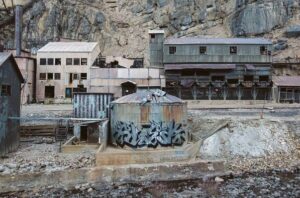 destructive force when it is turned loose on ruins. Right now, the townsite is a victim of vandalism, and the town’s main street is heavily tagged with graffiti. There are only a few intact windows left in town, as twenty years of vandalism have left almost every glass object in the town destroyed. Still, there are many parts of the town are almost as they were when the mine shut down. The main shaft elevators still sit ready for ore cars, permanently locked at the top level. Several cars and trucks still sit in their garages, left behind by their owners. Because of its size, modernity and level of preservation, the town is also the subject of interest for many historians, explorers, and photographers. I guess, “off limits to the public” doesn’t mean much.
destructive force when it is turned loose on ruins. Right now, the townsite is a victim of vandalism, and the town’s main street is heavily tagged with graffiti. There are only a few intact windows left in town, as twenty years of vandalism have left almost every glass object in the town destroyed. Still, there are many parts of the town are almost as they were when the mine shut down. The main shaft elevators still sit ready for ore cars, permanently locked at the top level. Several cars and trucks still sit in their garages, left behind by their owners. Because of its size, modernity and level of preservation, the town is also the subject of interest for many historians, explorers, and photographers. I guess, “off limits to the public” doesn’t mean much.

 For people who live in Casper, Wyoming, the mountain to the south has long been a great recreation area. They are campgrounds and a ski resort, not to mention the trails that dot the mountain top. While the mountain is mostly recreational today, along with a number of people who live on the mountain full-time, that wasn’t always the case. In 1890, a gold strike on Casper Mountain brought a little gold rush to the area…along with many different kinds of people, looking to strike it rich. The mountain was crawling with people from all walks of life, but while they looked until 1895, they didn’t find much gold. The materials found were mostly asbestos and other non-profitable minerals.
For people who live in Casper, Wyoming, the mountain to the south has long been a great recreation area. They are campgrounds and a ski resort, not to mention the trails that dot the mountain top. While the mountain is mostly recreational today, along with a number of people who live on the mountain full-time, that wasn’t always the case. In 1890, a gold strike on Casper Mountain brought a little gold rush to the area…along with many different kinds of people, looking to strike it rich. The mountain was crawling with people from all walks of life, but while they looked until 1895, they didn’t find much gold. The materials found were mostly asbestos and other non-profitable minerals.
Nevertheless, there arose a need for a town and supply stores, so the town of Eadsville was formed. It was located 12 miles due south of Casper on top of Casper Mountain. It was founded by Charles W Eads in 1891 after he had staked a 600-foot x 1,500-foot mining claim around a large spring. The town was named for one Charles W Eads, who was the second person to settle in Casper, following a Mr. Merritt, who was credited with being the first to locate to Casper. Eads appeared in the Natrona County Tribune, May 13, 1908, and was apparently accused of being a horse thief. He would go on to do time in prison.
It was thought that there were large deposits of precious minerals, such as gold, silver, lead, and copper. The town continued to develop, with lots being sold in the town during 1891 – 1892. During that time, about a dozen cabins were built. While the town became a ghost town before very long, the foundations of three cabins still remain today. During the boom years, some 40 to 50 people lived there, all hoping to make their millions in gold and silver. Some traces of gold and silver were found, and copper was also mined, but asbestos and feldspar were the most economical to mined. The “spar” was still being mined after nearly 100 years. It’s no longer being mined, but it could be again, if there was a need.
After a time of trying unsuccessfully to make a living, the miners finally gave up and abandoned the town 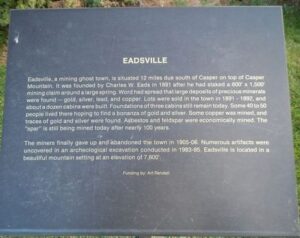
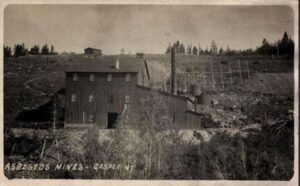 between 1905 and 1906. The site was rediscovered in the 1980s, and numerous artifacts were uncovered during an archeological excavation that was conducted between 1983 and 1985. At one time it was surveyed as a stamp mill. Eadsville was located on Casper Mountain at an elevation of 7,800 feet and covered an area 20 acres.
between 1905 and 1906. The site was rediscovered in the 1980s, and numerous artifacts were uncovered during an archeological excavation that was conducted between 1983 and 1985. At one time it was surveyed as a stamp mill. Eadsville was located on Casper Mountain at an elevation of 7,800 feet and covered an area 20 acres.
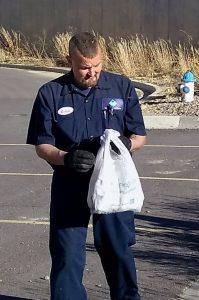 My nephew, Rob Masterson has been working at Sam’s Club in the Tire and Battery Center since August 1, 2017. Rob had not been able to work for some time, due to health issues brought on by his time in the service. The VA really wasn’t helpful to him, and after 4 plus years of waiting for them to decide on disability status, he’d had enough. Rob and his wife, Dustie were both unhappy with their current situation. Her job was not fulfilling, and they took her for granted. Then, Rob and Dustie basically stumbled on their jobs, and they will tell you that it was the best kind of accident to have. They were shopping at Sam’s club when they saw that Sam’s was hiring. They filled out the online application, and first Rob was called, and then Dustie. They were so excited to find that they would both be working at the same place. As Dustie puts it, “It’s amazing being able to work with your best friend. You know all the same people at work for the most part, and even though most people might find it weird to be able to discuss work and both know exactly what the other does, for us it’s just natural.” They did their orientation together, and both started on August 1, 2017. Rob actually started working before he completed the orientation, because his boss came in and said, “I need you now!” He would have to complete his orientation later. Rob, who has Rheumatoid Arthritis, was a little nervous about how his knees were going to handle the work, but he says that it hasn’t been too bad. Rob and Dustie prayed about his knees and ask for strength to be able to handle the work, and God answered their prayers.
My nephew, Rob Masterson has been working at Sam’s Club in the Tire and Battery Center since August 1, 2017. Rob had not been able to work for some time, due to health issues brought on by his time in the service. The VA really wasn’t helpful to him, and after 4 plus years of waiting for them to decide on disability status, he’d had enough. Rob and his wife, Dustie were both unhappy with their current situation. Her job was not fulfilling, and they took her for granted. Then, Rob and Dustie basically stumbled on their jobs, and they will tell you that it was the best kind of accident to have. They were shopping at Sam’s club when they saw that Sam’s was hiring. They filled out the online application, and first Rob was called, and then Dustie. They were so excited to find that they would both be working at the same place. As Dustie puts it, “It’s amazing being able to work with your best friend. You know all the same people at work for the most part, and even though most people might find it weird to be able to discuss work and both know exactly what the other does, for us it’s just natural.” They did their orientation together, and both started on August 1, 2017. Rob actually started working before he completed the orientation, because his boss came in and said, “I need you now!” He would have to complete his orientation later. Rob, who has Rheumatoid Arthritis, was a little nervous about how his knees were going to handle the work, but he says that it hasn’t been too bad. Rob and Dustie prayed about his knees and ask for strength to be able to handle the work, and God answered their prayers.
He applied for one transfer within the store, but didn’t get it and Dustie says, “I’m glad. When the position opened up to be the team lead over Tire Battery Center, I knew it was a perfect one for him.” I think they didn’t give him the first position, because they knew he was a great asset to the Tire and Battery Center, and they didn’t want to lose him. In the short time that Rob has worked at Sam’s, he has proven his worth. Dustie says that Rob is so nervous about being a supervisor again, but what he doesn’t realize that he is doing a great job. The people that he works with and the people that work for him have nothing but respect for him, and vice  versa. He treats everyone equally and with respect. You can see that he is so much happier…though more tired now, but she doesn’t think he will give it up…ever. He takes pride in his work and it shows. From sweeping the floor and taking out the trash to making sure the tires are correct in size and mounted properly. I think that Rob has always loved tinkering on cars, and so this was right up his alley.
versa. He treats everyone equally and with respect. You can see that he is so much happier…though more tired now, but she doesn’t think he will give it up…ever. He takes pride in his work and it shows. From sweeping the floor and taking out the trash to making sure the tires are correct in size and mounted properly. I think that Rob has always loved tinkering on cars, and so this was right up his alley.
Rob even has his special clients…the ones who ask for him, and who don’t want anyone else to work on their vehicle. One of them is a cute older woman who will not allow anyone else to work on her car, but Rob. Apparently her husband just recently passed away and he was the one who took care of everything on the car for her. When Rob helped her with her car, she was so relieved that someone truly cared, that she teared up. Dustie says, “I couldn’t be more proud of my husband. He is such a wonderful man and he’s making a lasting impression on this Earth and in Heaven. I couldn’t agree more. Today is Rob’s birthday. Happy birthday Rob!! Have a great day!! We love you!!
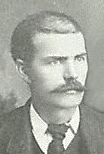 My husband, Bob Schulenberg’s 2nd great grandfather, Benjamin Franklin DeGood was a blacksmith in Galena, Kansas in 1900. He and his two oldest sons ran the business together, as often happened in families. If the parents were farmers, often so were the children. So in this case, because their dad was a blacksmith, William and Clyde grew up in the trade, and began working with him. In 1900, Galena was a town of 10,155 people…the largest population it had before or after that time. The railroad established the territory of Galena in 1871, but the town wasn’t established until the discovery of lead there in the spring of 1877. As with any mining operation back then, there were other occupations that became necessary, blacksmiths being one of them.
My husband, Bob Schulenberg’s 2nd great grandfather, Benjamin Franklin DeGood was a blacksmith in Galena, Kansas in 1900. He and his two oldest sons ran the business together, as often happened in families. If the parents were farmers, often so were the children. So in this case, because their dad was a blacksmith, William and Clyde grew up in the trade, and began working with him. In 1900, Galena was a town of 10,155 people…the largest population it had before or after that time. The railroad established the territory of Galena in 1871, but the town wasn’t established until the discovery of lead there in the spring of 1877. As with any mining operation back then, there were other occupations that became necessary, blacksmiths being one of them.
Benjamin and his family were living in Nebraska, when Bob’s great grandmother, Nellie DeGood Knox was born in Springfield on October 6, 1887, but by the birth of her younger brother Ernest on December 31, 1892 the family was living in Columbus, Kansas. By the December 9, 1898 birth of Benjamin’s youngest daughter, Beulah, the family was living in Galena, Kansas. Then in the 1900 census, Benjamin and his two eldest sons had a blacksmith shop in Galena.
I have to wonder what it was like to be a blacksmith in the 1900s. Cars had made their first appearance on the scene in 1893, and while I’m sure many people were sure they were a passing fad that was less than safe. It’s also quite possible that they were too expensive for the average person, but as a blacksmith, I have to wonder if Benjamin could see the writing on the wall. The days of the blacksmith having steady work were numbered. Nevertheless, he had to continue to do the job he knew as long as there was work to do.
At some point after the untimely deaths of Benjamin’s youngest daughter, Buelah and son,  Theodore, both of whom died as young children, and possibly because of the declining need for blacksmith services, or maybe due to declining health, Benjamin moved the family that was still at home, to Polk, Missouri. I have not found any real indication of declining health, but given the fact that blacksmiths in those days were exposed to asbestos, before we knew of the dangers, I have to think that a man who dies at 58 years of age, even as early as 1907, must have had something major going on. Lung diseases caused by asbestos would definitely qualify. I would think that the life of a blacksmith would be a hard one in every way, and when it brought with it an early death due to the occupational health hazards, it became an occupation I wouldn’t want my kids to go into…even if it was the family business.
Theodore, both of whom died as young children, and possibly because of the declining need for blacksmith services, or maybe due to declining health, Benjamin moved the family that was still at home, to Polk, Missouri. I have not found any real indication of declining health, but given the fact that blacksmiths in those days were exposed to asbestos, before we knew of the dangers, I have to think that a man who dies at 58 years of age, even as early as 1907, must have had something major going on. Lung diseases caused by asbestos would definitely qualify. I would think that the life of a blacksmith would be a hard one in every way, and when it brought with it an early death due to the occupational health hazards, it became an occupation I wouldn’t want my kids to go into…even if it was the family business.
 As Bob and I were on our walk on the Mickelson Trail last week, we came across an informational sign on the Homestake Mine. I was really quite surprised as some of the information it contained. Of course, I had read about the discovery of gold in the Black Hills of South Dakota…who hadn’t. The exact date of the discovery is unknown, but the discovery brought many people to the Black Hills…which was in direct violation of the treaty with the Lakota and Cheyenne Sioux Indians. That discovery also brought about the Great Sioux War of 1876…also known as the Black Hills War. Most people will remember that it was during this war, that George Armstrong Custer made his last stand at The Battle of The Little Big Horn.
As Bob and I were on our walk on the Mickelson Trail last week, we came across an informational sign on the Homestake Mine. I was really quite surprised as some of the information it contained. Of course, I had read about the discovery of gold in the Black Hills of South Dakota…who hadn’t. The exact date of the discovery is unknown, but the discovery brought many people to the Black Hills…which was in direct violation of the treaty with the Lakota and Cheyenne Sioux Indians. That discovery also brought about the Great Sioux War of 1876…also known as the Black Hills War. Most people will remember that it was during this war, that George Armstrong Custer made his last stand at The Battle of The Little Big Horn.
The Homestake Mine, near Lead, South Dakota, was founded in 1876 and while it changed hands several times, it was in operation until all the gold mines were mandatorily shut down to encourage the miners to work in more important fields to help with the war effort in World War II. The thing that surprised me the most was that most of the gold mines did not reopen after the war was over. Gold is such a valuable metal, so why would the mines not reopen? One thought comes to mind. Gold was mined underground, sometimes deep underground, as in the case of the Homestake Mine. Underground mining is dangerous as we have seen over the years, with cave-ins and blasts from the gases that can be found there. I have to wonder if the men decided that the new skills they had learned during World War II were a better way to make money and maybe, stay alive.
Nevertheless, the Homestake mine was one that reopened after the war, and then went on to continue to be a successful mine until their last production of ore in 2001. The Homestake Mine ceased production at the end of 2001, due to low gold prices, poor ore quality, and high costs. The Homestake Mine Company had merged with The Barrick Gold Corporation and they were dewatering the mine as DUSEL negotiations continued. This was a slow process and very expensive at $250,000 per month. The mining company was having great difficulty justifying the cost, and the process ceased on June 10, 2003 and the mine was closed completely.
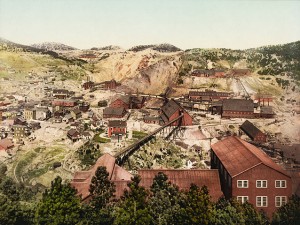
These days, there are a number of operating gold mines around the country, but the state with the largest production of gold is Nevada. The need and desire for gold did not cease after World War II, it was probably just more that a lot of mines didn’t produce the quality or quantity that was really needed to be successful. It almost seems as if the closure of the mines in World War II had a greater impact than anyone would have ever expected. Whatever her end was, the Homestake was not a casualty of the World Wars, and went on to become the longest continuously operating gold mine in the world.

